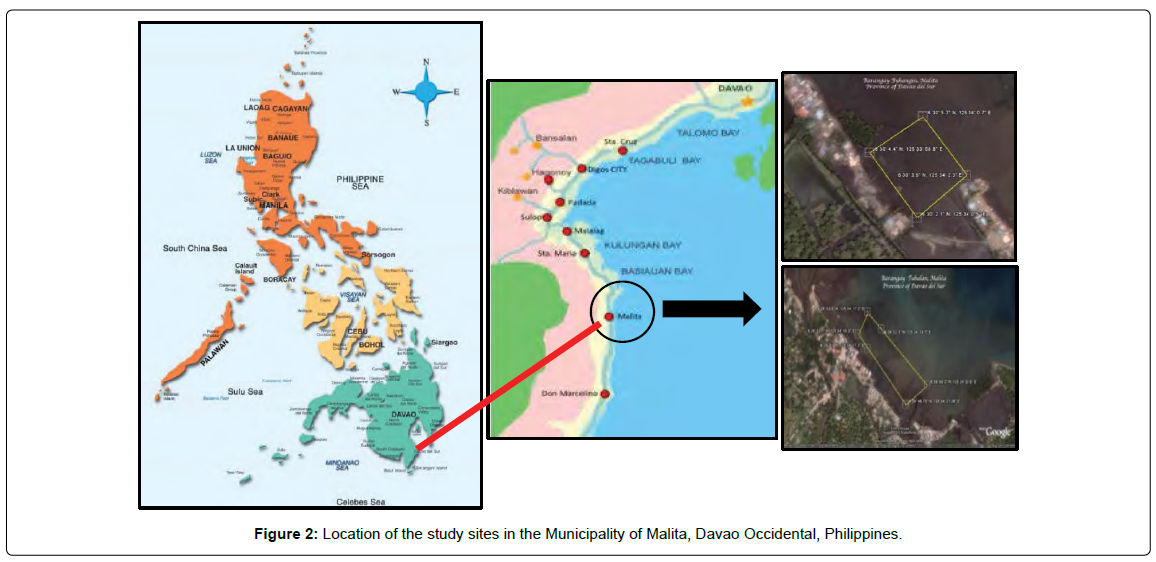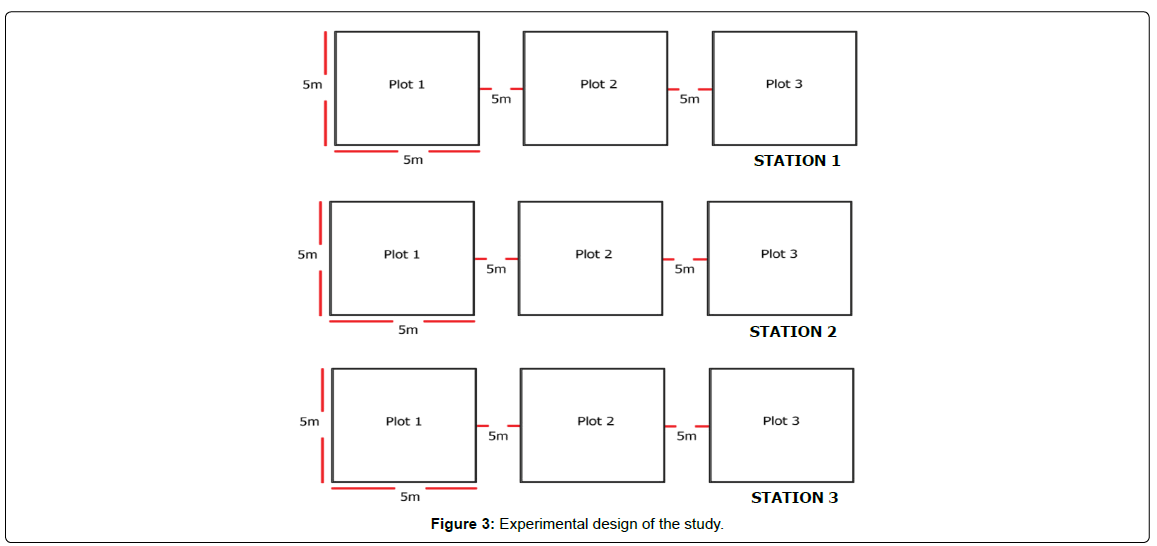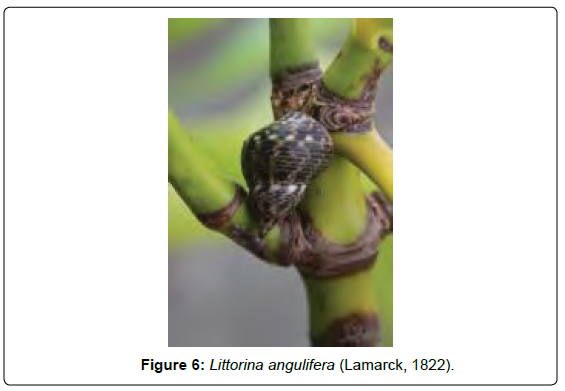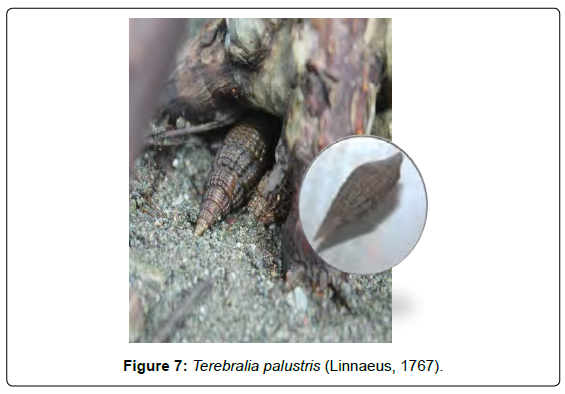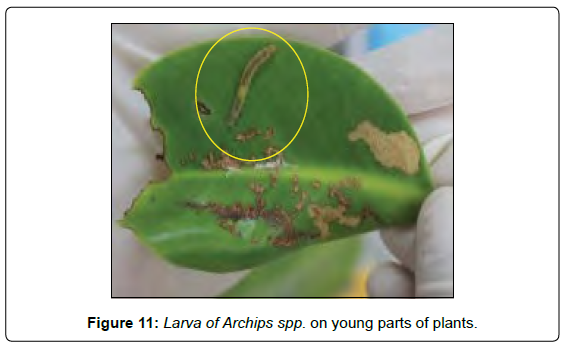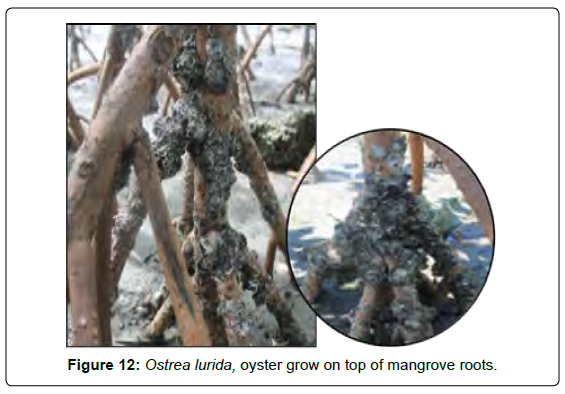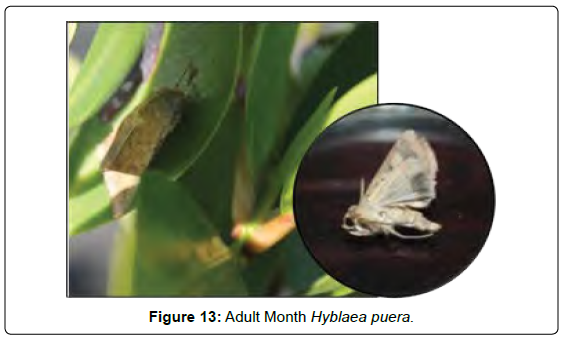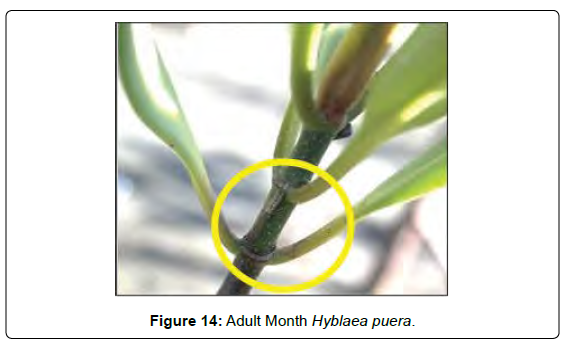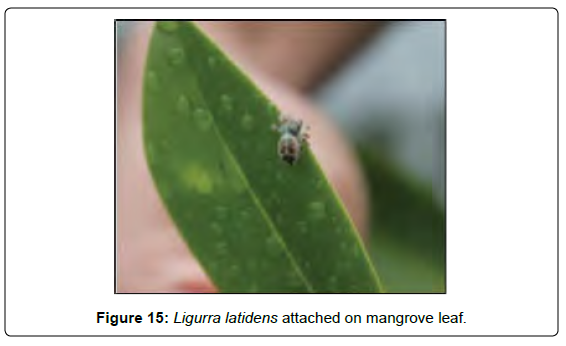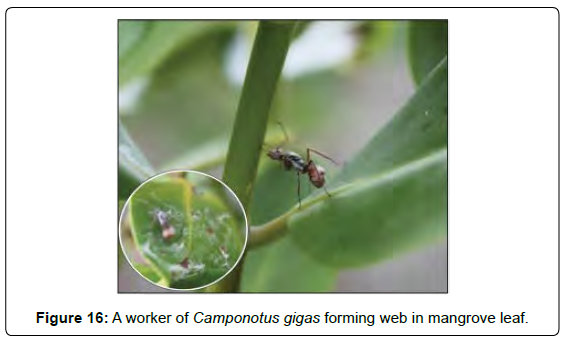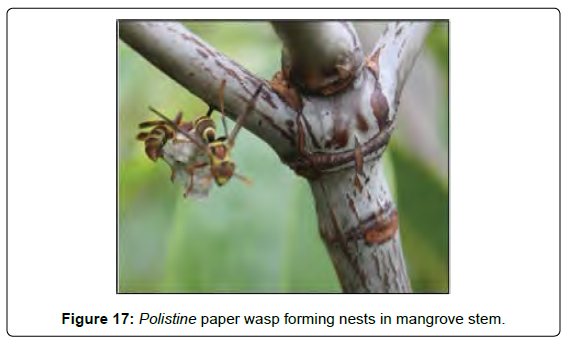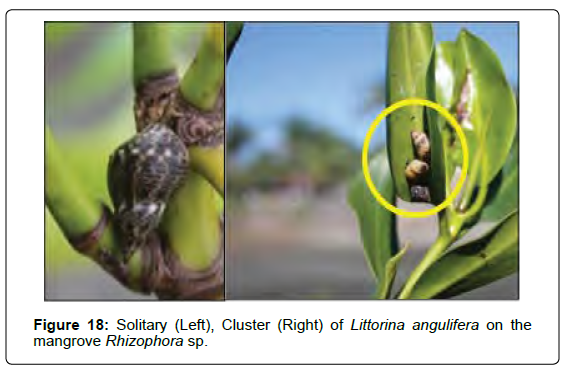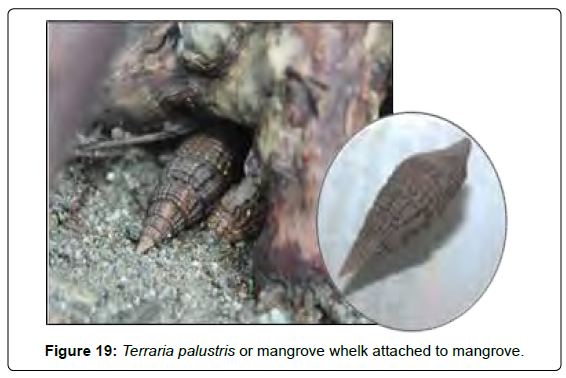A Case Study of Insect Pests and Disease-Causing Microorganisms In Mangrove Saplings in Davao Occidental, Philippines
Received: 22-Sep-2021 / Accepted Date: 19-Oct-2021 / Published Date: 26-Oct-2021 DOI: 10.4172/2155-9910.1000336
Abstract
The study was conducted to determine the incidence and characterize insect pests and disease-causing microorganisms associated with planted mangrove Rhizophora sp. saplings in the two PNAP selected sites of Davao Occidental. The study was focused on the Rhizophora species as this mangrove species showed high dispersal patterns and exhibit a high percentage of planted mangroves covered during the implementation of the project.
There were eight species identified in terms of the level of infestation based on insect-pest occurrence under Phylum Arthropoda (1 Class Malacostraca: Aratus pisonii (Mangrove Tree Crab), 1 Bivalvia: Ostrea lurida (Olympia oyster), 2 Arachnida: Tetragnatha josephi (Mangrove big-jawed spider) and Ligurra latidens (Mangrove jumper) and 4 Insecta: Camponotus gigas (Giant Forest Ant), Polistes versicolor (Polistine Paper Wasp), Hyblaea puera (Teak defoliator) and Archips spp. (Tortrix). Among the recorded insects, four species were considered harmful to the mangrove ecosystem. They were Aratus pisonii (Mangrove Tree Crab), Ostrea lurida (Olympia oyster), Archips spp (Tortrix), and Hyblaea puera (Teak defoliator). Other four species were classified harmless namely Tetragnatha josephi (Mangrove big-jawed spider), Ligurra latidens (Mangrove jumper), Camponotus gigas (Giant Forest Ant), and Polistes versicolor (Polistine Paper Wasp).
Moreover, three-leaf diseases were noted in the samples i.e., leaf spot, leaf blight, and leaf chlorosis. For leaf spot, three species of fungi were identified Cercoscopra sp, Acrenomium sp, and Cladosporium sp., whereas, for leaf blight, two fungal species were observed Rhizoctonia sp and Phytophthora sp. Upon further verification, leaf spot and leaf blight were caused by fungi, whereas leaf chlorosis was affected by bacteria. Relationship on the level of infestation and extent of incidence in mangrove Rhizophora sp. saplings showed a high positive correlation degree of relationship with a value of ±745. This implies that when the level of infestation increases, the disease incidence correspondingly increases.
Keywords: Mangroves; Ecosystem; Insect pests; Infestation; Incidence
Introduction
Mangroves are tree, shrub, palm, or ground fern, generally exceeding a one-half meter tall, and which normally grow above mean water level within the intertidal zone of marine coastal environments, or estuarine margins and constitute one among the foremost threatened ecosystems despite their numerous goods and services like for charcoal, housing materials, boat construction, and medicine [1-4]. The mangrove ecosystem is known for its high productivity due to the massive reservoir of carbon from roots and leaves with mean net primary productivity approximates of two to five mg C ha-1 year- 1 [3] making them the primary nutrient source for several organisms from different trophic levels [5]. It is a habitat for various associated communities of flora and fauna which are composed of diverse organisms that dwell in various mangrove niches like on the surface of the substrate, underneath the substrate, on fallen leaves, on trunks, and within the water. Thus, it is concluded that biomass in mangroves is greater than in the other aquatic system [6-8].
Despite the biological significance of mangroves, they suffered considerable degradation. It has been documented that serious stunting of growth and mortality of planted mangroves is in high incidence to numerous mangrove rehabilitation and conservation programs exhibited in several coastal areas [9]. There has been a drastic decrease in the habitats of mangroves within the Philippines. The Philippines have lost quite half the mangroves with 240,800 hectares remaining as of 2010. It continually disappears at a rate of 0.66% per annum between 2000 and 2005.
With this scenario, massive rehabilitation efforts are done by different non-government, government organizations, and private agencies within the Philippines which aim to restore the natural vegetation in heavily degraded areas, prevent coastal erosion, facilitate coastal fisheries, and protect swamps within coastal communities [10].
Consequently, SPAMAST with the partnership of the Bureau of Fisheries and Aquatic Resources (BFAR) in Region XI has entered into a Memorandum of Agreement to implement the Mangrove Rehabilitation and Conservation Project under the Philippine National Aquasilviculture Program (PNAP) to all coastal barangays within the Province of Davao Occidental. A total of 636,000 mangrove propagules were planted and indicated a 58.47% survival rate along the coastal stretch of the Province. It had been observed that there’s a high prevalence of dieback and mortality of planted mangrove species during the implementation of the Philippine National Aquasilviculture Program (PNAP) within the province. The study revealed that the factors which contributed to the low survival rate of mangrove plantations are because of infestation of pests, barnacles, oyster, and astray animals [11-16]. Likewise, Physico-chemical parameters like water salinity, pH, direct exposure to sunlight, and also anthropogenic activities by the local settlers like using fish gears, boat traffic, and gleaning were also noted.
Given the experience of insect pest infestation incidence within the planted mangrove within the province, this study aimed to identify the insect pest and other disease-causing microorganisms of planted mangrove Rhizophora species saplings specifically within the municipality of Malita covering the two (2) recipient barangays of the project (Buhangin and Tubalan). Pests are classified into insects, weeds, plant pathogenic fungi, bacteria, viruses, etc. It has been shown that diseases contributed by these factors have significant effects on plant survival, growth, and fitness in natural ecosystems. Thus, the enormous invasion of those organisms to the mangrove ecosystem must be studied and premeditated. The study was focused on the Rhizophora species as this mangrove species showed high dispersal patterns within the locality and exhibits a high percentage of planted mangrove-covered within the PNAP selected study sites [17].
Objectives of the Study
The main objective of this study is to determine the incidence and characterize insect pests and disease-causing microorganisms associated with planted mangrove (Rhizophora sp.) saplings in PNAP selected sites. Specifically, the following were the objectives:
1. To determine the level of infestation of insect pest and diseasecausing microorganisms in planted mangrove Rhizophora sp. saplings in PNAP selected sites in terms of;
a. Insect Pest occurrence
b. Diseases
c. Other Pests
d. Colony counts of causal agents (Fungi and Bacteria)
2. To determine the extent of the incidence of pest and diseasecausing microorganisms in planted mangrove Rhizophora sp. saplings in PNAP selected sites.
3. To describe the morphological characteristics exhibited by plants infested by pests and other disease-causing microorganisms in mangrove Rhizophora sp. saplings in PNAP selected sites.
To verify the significant relationship on the level of infestation and extent of disease incidence in planted mangrove (Rhizophora sp.) saplings in PNAP selected sites.
Significance of the Study
Purposively, the data that was gathered from this study will provide quantitative information in terms of the biology, ecological effect, nature of the damage, possible control and convey out systematic survey list of the pests and disease-causing microorganisms’ interactions in planted mangrove Rhizophora sp. saplings in PNAP selected sites of the municipality of Malita, Davao Occidental, Philippines.
Relatively, this study served as a basis for government, nongovernment organizations, peoples’ organizations, researchers, policymakers, academicians, and other partner agencies in crafting the Mangrove Management Plan and can support future related researches taking into consideration the prevalence of those pests and diseasecausing microorganisms as one of the factors contributing to the mortality of planted mangroves species [18].
Definition of terms
Arthropods: Any invertebrate of the phylum Arthropoda, having a segmented body, jointed limbs, and usually a chitinous shell that undergoes moltings, including the insects, spiders and other arachnids, crustaceans, and myriapods.
Bacteria: Are microscopic living organisms, usually one-celled that can cause infection or as parasites.
Characterization: The act of describing the character, qualities, or peculiarities of animals or plants.
Colony Forming Unit (CFU): A unit to measure viable cell count.
Disease: A condition of the living plant body or of one of its parts that impairs normal functioning and is typically manifested by distinguishing signs and symptoms.
Disease-causing microorganisms: Any biological pathogen that transmits a disease which includes bacteria, viruses, fungi, and parasitic worms.
Extent: The degree to which something has spread; the size or scale of something.
Fungi: An organism that lacks chlorophyll and feeds on organic matter, ranging from unicellular to multicellular organisms to sporebearing syncytia.
Gastropods: Any mollusk of the class Gastropoda, comprising the snails, whelks, slugs, etc.
Harmful: A threat or involving possible injury, damage, or death.
Harmless: Lacking capacity or intent to injure; not meant to cause harm or damage
Incidence: Is the occurrence, rate, or frequency of a disease or something else undesirable.
Infestation: This is the state of being invaded or overrun by pests or parasites and refers to the actual organisms living on or within a host.
Insects: Any animal of the class Insecta, comprising small, airbreathing arthropods having the body divided into three parts (head, thorax, and abdomen), and having two antennae, three pairs of legs, and usually have two pairs of wings.
Mangrove: Are coastal trees or shrubs that are adapted to estuarine or even saline environments (Calumpong et al.; 1995).
Morphology: Is a branch of biology that deals with the form and structure of animals and plants.
Mortality: Is a measure of the number of deaths (in general, or due to a specific cause) in a particular population, scaled to the size of that population, per unit of time.
Nematodes: An unsegmented worm of the phylum (or class) Nematoda, having a tough outer cuticle that includes free-living forms and disease-causing parasites.
Pathogen: Is a biological agent that disrupts the normal physiology of an organism or causes disease or illness to its host.
Pest: Is defined as any species, strain, or biotype of plant, animal, or pathogenic agent injurious that cause damages with high mortality of plants or plant products.
Plant Disease: This is a harmful alteration of the normal physiological and biological development of a plant caused by animal agents.
PNAP (Philippine National Aquasilviculture Program): A program that covers the Mangrove Rehabilitation and Enhancement Projects implemented in Davao del Sur which includes Barangay Tubalan and Buhangin as identified selected sites for the study.
Quadrat: It refers to the 5 m × 5 m device used to determine mangrove species found in the area.
Rhizophora: This is a genus of tropical mangrove trees, with exposed roots that are sometimes collectively called true mangroves, classified as Red mangroves belonging to the Family of Rhizophoraceae.
Sapling: A young tree; specifically: not exceeding 1-2 meters high and distinguished not more than 400 leaves.
Signs: Are the visible parts of the pathogen or its products seen on the host that can be used to identify the pathogen.
Species: Are a group of individuals having common attributes that share the same gene pool.
Symptoms: Are the visible reactions or manifestation of a plant to a disease and may suggest a causal agent.
Virus: This is a pathogenic, ultramicroscopic infectious agent that replicates itself only within cells of living hosts.
Research Study
The Philippine National Aquasilviculture Program (PNAP) is a realistic framework of conservation and sustainable resource management program of the Department of Agriculture (DA) being implemented by the Bureau of Fisheries and Aquatic Resources (BFAR). A partnership between the Bureau of Fisheries and Aquatic Resources (BFAR) and the Commission on Higher Education (CHED) was established to launch the said program that covers at least 71 State Universities and Colleges (SUC’s) and 61 provinces throughout the country. The program aims to protect and restore habitats for fisheries and aquatic resources, establishment of community-based hatcheries, mangrove habitat rehabilitation and conservation, and providing alternative sustainable livelihood to the community at the same time empowering them as wardens of the ecosystem [19].
Acknowledgements
Evaluations on the successful implementation of the program have been done specifically on the Mangrove Rehabilitation and Conservation Project. Studies revealed some contributing factors that influenced the low survival rate of mangroves as noted in the PNAP sites. Jimenea and Lugo mentioned that calamity like flooding is one of the causes of high mortality of planted mangroves. Further, unsuitable choice of mangrove species by planting only Rhizophora sp. in all locations without regard to the specific-site natural mangrove zonation as noted one of the causes of failure in mangrove rehabilitation projects.
A study of Pacyao revealed other factors contributed to negative impacts on mangrove survival which include the infestation of pest, barnacles, and oysters, astray animals, the physicochemical parameters (water salinity, pH and the direct exposure to sunlight in the area, and the anthropogenic activities done by the local settlers (used of fishing gears, boat traffic, and gleaning).
Morphology of Mangrove
Mangrove (Rhizophora sp.) is a broad-leaved evergreen tropical shrub or tree that may reach 24 meters. Rhizophora leaves require four months to mature. It has conspicuous arching prop, or stilt, roots. Older bark is reddish and smooth; younger bark is grayish. Twigs are silverish to shiny dark brown. The stalked, oppositely arranged leaves (5 to 16 cm long and up to 8 cm wide) are simple, entire, and smooth, with a prominent midrib. They are leathery, dark green and shiny above and lighter green (often speckled) below. The somewhat leathery, 4-petaled flowers are pale yellowish or cream-colored. They are borne on stalks (about 1 to 4 cm long) in clusters of 2 or more. The fruit is an elongate greenish capsule, about 2.5 cm before germination. The seed germinates while still on the plant, giving the fruit a curved, elongate appearance.
Mangroves species of the Family Rhizophoraceae are characterized by vivipary where the embryo develops a seedling while still forming part of the fruit attached to the parent tree. After release, mangrove propagules (Rhizophora sp.) float and are dispersed by water. Propagule dispersal, establishment, and recruitment of the sapling stage are critical steps in the life cycle of mangroves [20-24] which determine their capacity to maintain their populations and colonize new habitats.
Moreover, insect herbivory of propagules, seedlings, and foliage can be an important disturbance mechanism in the mangrove forest and affect forest structure [12].
Importance of Mangrove Species
Mangroves have a lot of economic uses for humans. In fisheries alone, various seafood products are harvested in mangrove areas such as mud crabs, shrimps, mollusks, and fishes. In Southeast Asia, 77% of all mangrove species are known for their many uses, from which 41% is for medicinal use, 25% for construction materials, 22% for food and consumption, 17% for ornamental use, and at least 12% for fuel. Moreover, mangrove ecosystems can also be utilized for ecotourism and education. Among other countries, the Philippines utilize mangrove forests for fish production, fuel and responsible tourism. Further, mangroves roots are used to treat diarrhea; stem- a bark decoction is used to treat frequent dysentery, diarrhea, micturition, and bladder diseases; bark is febrifuge, astringent, rich in tannin, used in a decoction in French Guiana for hemorrhages, and in gargles to remedy angina and used to treat diarrhea in NW Guyana.
Other important functions of mangrove trees are coastal protection and serving as bio-indicators. Mangrove forests act as barriers to waves, wind, and cyclones by trapping sediments, and reducing and breaking waves. They also filter the bodies of water serving as sinks for sequestering pollutants and contaminants carried by tidal inundations from different sources of water. Specifically, red mangrove (Rhizophora sp.) is a potential source of botanical insecticides. There was a study conducted on the insecticidal activity of extracts derived from different parts of this mangrove species against the three arthropods; and revealed, that bulk of the active compounds are sequestered in the bark, pith, and stem wood with the least being found in the leaves. Rhizophora aqueous bark extracts also have been used as antiseptic and skin-wound healing.
Mangroves are traditionally used as antimicrobials. Emerging antibiotic resistance among the pathogenic microorganism has triggered the discovery of various antimicrobial compounds from this marine source.
Characteristics of Mangrove Insect Pests
Insects are the only class of animals that are so intimately involved in the intricacies and complexities of the biological world. The insects especially the bees accomplish 80% of the pollination in forests (Washington, 1952). Most of the vegetation in the forests will always have to depend on native insects for their reproduction and ecobalance. Insects destroy or damage all kinds of growing crops and other valuable plants [25]. They chew and suck the sap of the leaves, buds, stems, bark or fruits. Several species of coleopterans attack timber trees and can cause serious economic damage.
The main insect-feeding guilds or groups found on planted mangrove seedlings are defoliators, sap feeders, bark and woodfeeders, and seed borers. The first feeding guild, the defoliators, damage mangrove seedlings by feeding on leaves directly through chewing, mining, eating away leaf tissues and leaving behind leaf veins, and feeding within shelter constructed from rolled leaves. The sap feeders, mostly the Hemiptera or plant bugs, suck sap from leaves, stems, and other plant parts. Bark- and wood-feeding insects are another guild infesting replanted mangrove trees. Lepidoptera, specifically larva of the wood moth Zeuzera conferta, damages trees by tunneling through the stem. Fruit- and seed-borers such as beetles from the family Scolytidae, on the other hand, bore through propagules rendering them weakened even before they are planted out in the mudflats.
Insect Pests and Disease-causing Microorganisms of Mangroves
The mangrove invertebrate fauna plays a significant role in detritus production and energy flow in the mangrove inshore system. The turnover rate of nutrients is also increased by these attacks by the mangrove insects. The rich insect fauna found in colonizing dead mangrove tree trunks and fallen timber increase the detritus formation. Mangrove insects have been studied from Southeast Asia, Thailand and India. These works give much detail on the biology and host plant identification. Timber beetles of Ranong mangroves were studied by Murphy and Meepol. Murphy and Rau studied the ground mesofauna and herbivore attack on Ranong mangroves. Mangrove butterflies, nymphaline moths from Singapore, and crickets from Malaysia were studied. Mangrove ecosystem possesses technical problems for faunal studies [26].
In this study, 113 species of insects were identified from Muthupet mangroves. The insects were classified into eight orders and 53 families. 94 insects were identified up to species level and 12 insects up to genus level and one insect up to family level, while six insects up to order level. The maximum number of 28 species were found in the order Lepidoptera and Coleoptera (28 species), Hemeptera 11 species, Odonata 10 species, Diptera 6 species, and Isoptera with the minimum number of two species. Insects belonging to 11 families of Lepidoptera and 14 families of Coleoptera were dominant. The dominance of Lepidopterans was also observed in Pichavaram mangroves. The butterflies and moths pollinate mangroves and these Lepidopterans mainly in their larval and developing stages depend on mangrove plants. Lepidopterans are voracious feeders and these feed upon the leaves and buds of mangroves. The numbers of Coleoptera are the subdominant species of Muthupet [27]. In the mono generic stands of Avicennia, Necrophorus, Marginetus are common. The wood boring coleopteran species like Separds calcarata and Trichobaris trinotata are common in Exoecaria agallocha plants.
The larvae and adults possess chewing mouthparts and long snout which enable them to feed the inner tissues and make deep holes in the wood for depositing eggs. Hymenopteran Chalcis crule, a predator of caterpillars Nutilla sexmaculata and Polistes annularis are the common wasps of Muthupet mangroves. The nests of Polistes annularis were found largely of Avicennia trees. Apis florida and Apis dorsata and Apis mellifera are the commonest honey bees. The nests of leaf-cutting bee Megachile latimans, mining bee, Andren wilkella, and the Carpenter bee Xylocopa vilolaceae were observed on the Exoecaria woods. Apis dorsata and Apis mellifera were the honey bees reported from Sunderbans [28]. The weaver ant Oecophylla sp. construct nests by spinning the edges of mangrove leaves together with the carpenter ant Componatus sp. and thief ant Solenopsis sp. preferably construct their nests in rotten and decaying Exoecaria woods.
Hemepteran bugs are chiefly terrestrial, some are aquatic and semi-aquatic habitats. Murgantia sp. and Zezura sp. were found to be colonizing on the lower leaf surface of Exoecaria. Triatoma sp., Hemicocephalis baslis, and Leptocorisa varicornis were parasitic and Loccotrephus sp. was observed in semi-aquatic mangrove habitat. Among the delicate Odonates Aeschnid sp. and Rhyotherus varigata were of common occurrence. The orhtopteran Neoconocephalus sp, Paraterettix cuculatus were the significant pests on mangrove vegetation. Mantis religious and cricket Gryllus assincilus were the beneficial insects that feed on small parasitic insects on vegetation [29]. The termites from the order Isoptera colonize in dead mangrove trees and increase detritus formation. Dipterans Tabannus striatus is a bloodsucker. Culex sp, Aedes sp, and Anaphelus sp. were the common mosquitoes. The presences of these species were recorded from Sunderbans by Naskar and Guhabakshi.
Based on the feeding habits of the insects collected from Muthupet 75% of them are considered harmful and 25% harmless. Muthupet, the mangrove belt of river Cauvery is a unique ecosystem having rich and diversified insect fauna. These faunal assemblages play a dominant role, not in pollination and detritus formation, but reflect on the fertility and productivity of the ecosystem.
Statistics showed that 9,800 mμ (653 ha.) of mangrove forest was raided by the insect pest, and the death rate of the affected mangroves has reached as much as 70% [17]. In China, a study by Fan Hangqing et al. indicated that the thematic pests were Oligochroa cantonella larva with the addition of a few larvae of Pseudcatharylla duplicella and adults of Euricania sp. The insect of O. cantonella prefers leaves, resulting in dry of leaf and death of twig leading to maximum damage of 73% forest leaf area. Laboratory incubation revealed Brachymeria sp. and Tetrastichus sp. may parasitize the pupae of O. cantonella, and terminate its process of eclosion. Inundation of seawater on stands can restrain pest infestation. Another study showed a new mangroveinfesting species named Aulacaspis marina occurrence in Southeast Asia, which recorded as a serious pest of the mangrove Rhizophora in Bali Is. (Indonesia), is described based on specimens from Bali Is., Palawan Is. (the Philippines), and Matang, the Malay Peninsula (Malaysia).
An incident happened in South China when an insect pest has made a surprise attack on a mangrove forest. According to Fan Hangqing et al., Director of Research Center on Mangrove Forest, the destruction was caused by a kind of caterpillar, which reproduced four generations in less than a week. The pest attacked the back of leaves first, preventing the regular process of photosynthesis on the mangrove trees [30-34]. As a result, the attacked plants shrink and dry, and if no new sprouts grow out, they will die out completely. Fan, therefore, concluded that the pest attack should be a sign of a destroyed mangrove ecosystem.
An incidence of gall disease of red mangrove caused by Cylindrocarpon didymium, the new disease of Rhizophora was observed in various coastal areas. Galls of <1-20 cm diameter occurred on the trunks, branches, and prop roots, primarily at nodal and wounded areas. At some locations, infection was 100%. C. didymum was consistently associated with and isolated from, gall tissue, and pathogenicity was established with field inoculations. Six months after inoculation, initial symptoms appeared as roughened, callused tissue from which the fungus was readily re-isolated. It produced indoleacetic acid in vitro.
Another study in Indonesia showed that the most common pests of mangroves are scale insects that attach themselves to the shoots and feed on the plant sap, which often causes the leaves to wilt [35]. As well as burrowing isopods, such as Phycolimnoria clarkae and Sphaeroma peruvianum, and encrusting barnacles (Balanus spp.) reduce root growth in Red Mangrove; leaves are consumed by land crabs and caterpillars, such as the larvae of the skipper Phocides pigmalion.
Further, an intertidal air-breathing gastropod Melampus coffeus is a critical component in the breakdown of mangrove leaf litter, and it forms an important link between mangrove forest productivity and estuarine food webs. Although some other invertebrate species act to accelerate litter breakdown in mangrove and salt-marsh systems (e.g., shredder snails, sesarmid crabs), M. coffeus belongs to a smaller group that can directly assimilate the resources in mangrove leaves. Thus, where M. coffeus is abundant, substantial portions of mangrove leaf material are converted to snail biomass and larvae. Adult snails are preyed upon by white ibis (Eudocimus albus); juvenile snails may be preyed on by Fundulus heteroclitus killifish, which may forage in the leaf litter at high tide; and larvae are exported to the estuary [36].
Associated Disease-Causing Microorganisms
Bacteria
Bacterial groups are found in different parts of the mangroves dwelling on surfaces as epiphytes, on leaves like the Flavobacterium, on the stem where plentiful Vibrio spp. are situated, on pneumatophores like the cyanobacteria, which also grow in any immersed surfaces and in the rhizosphere that was observed to have an impact on the activity of microorganisms. The microbial population that grows in the rhizosphere can settle in the roots of a mangrove sapling, and live on for a prolonged time after the saplings are relocated. Bacteria are microscopic, single-celled organisms. Bacteria multiply rapidly by simple cell division and absorb nutrients from their immediate environment. Bacterial pathogens are introduced to new sites on contaminated seed or transplants. Once established, bacteria are spread by splashing rain, water runoff, wind-driven rain or mists (aerosols), equipment, insects, and people working around the plants.
Bacteria as plant pathogens can cause severe economically damaging diseases, ranging from spots, mosaic patterns, or pustules on leaves and fruits, or smelly tuber rots to plant death. Some cause hormone-based distortion of leaves and shoots called fasciation or crown gall, a proliferation of plant cells producing a swelling at the intersection of stem and soil and on roots [37]. Bacteria associated with plants have several morphological shapes as can be seen with conventional microscopes at 400x to 1000x magnification. These shapes initially provided simple ways to differentiate them. There are bacilli (rods), cocci (spherical), pleomorphic rods (tendency toward irregular shapes), and spiral shapes. The majority of plant-associated bacteria are rods.
Fungi
Fungi are filamentous organisms that are microscopic, but some produce large structures. There are about 8,000 fungal species that cause plant diseases. Since fungi lack chlorophyll they cannot manufacture their food, therefore, need to draw their sustenance from other living things. Fungi grow as microscopic threads or filaments that branch in all directions [38]. The pathogenic fungi infect chiefly the top of the mangrove plant. Diseases occur mostly on leaves, then on the tip of the branch, and rarely on the root and stem.
In a study in southwestern Puerto Rico, Wier found cankers, dead branches and trunks, and as much as 32% mortality consistently associated with the fungus Cytospora rhizophorae. The presence of this fungus, an agent of the Cytospora canker disease, correlated with proximity to arboreal nests of the termite Nasutitermes costalis. A high incidence of this termite (40%) was detected in injured red mangroves (Rhizophora sp). Wier presents circumstantial evidence that this fungus is carried and disseminated by Nasutitermes costalis, with spores that enter branch and root wounds germinating and forming cankerweakened trees that may die prematurely [39].
Virus
Viruses are particles that are smaller than a single cell and not visible through a light microscope. Most viruses are spread by insects, but some are spread mechanically through the exposure of plant wounds to infected sap. In insect transmission, plants become infected by the probing (sampling) and feeding activities of the insects such as aphids, thrips, and leafhoppers that carry viruses (vectors). Once inside the plant, the virus multiplies and spreads throughout the plant. Virus infection causes a wide range of symptoms including unusual color patterns in leaves and fruit, distorted growth, plant stunting, reduced yield, and plant death [40]. Symptoms of plant virus infection include malformed leaves, black streaks on the stems, discoloration of the leaves and fruits, and ring spots.
One class of viruses, the Rhabdoviridae, has been proposed to be insect viruses that have evolved to replicate in plants. The chosen insect vector of a plant virus will often be the determining factor in that virus's host range: it can only infect plants that the insect vector feeds upon.
Nematodes
Nematodes are microscopic roundworms that live in the soil. Some nematode species feed on plant roots and cause diseases. Repeated cropping of susceptible crops may result in nematode populations rising to levels that cause economic damage. Reduced plant growth and yield result from the poor root development and function caused by nematode feeding. Nematodes are most damaging in warm sandy soils. Poorly drained soils with high clay content often do not support high nematode populations. Low population levels generally do not cause damage, and may even stimulate plant growth.
Plant-parasitic nematodes range from 250 um to 12 mm in length, averaging 1 mm, to about 15-35 um in width. All nematodes undergo four molts from the juvenile to the adult phase of their life cycle. Many plant-parasitic nematodes feed on the roots of plants. The feeding process damages the plant's root system and reduces the plant's ability to absorb water and nutrients. Typical nematode damage symptoms are a reduction of root mass, a distortion of root structure, and/or enlargement of the roots. Nematode damage of the plant's root system also provides an opportunity for other plant pathogens to invade the root and thus further weakens the plant. Direct damage to plant tissues by shoot-feeding nematodes includes reduced vigor, distortion of plant parts, and death of infected tissues depending upon the nematode species.
An example of plant nematodes is the root-knot nematodes. They are plant-parasitic nematodes from the genus Meloidogyne. About 2,000 plants are susceptible to infection by root-knot nematodes and they cause approximately 5% of global crop loss. Root-knot nematode larvae infect plant roots, causing the development of root-knot galls that drain the plant's photosynthate and nutrients. Infection of young plants may be lethal, while infection of mature plants causes decreased yield (Figure 1).
Materials and Methods
Research Locale
The study was conducted in the two PNAP selected sites of coastal barangays of Malita, Davao Occidental, and Philippines. The identified sites had existing mangroves as part of the Philippine National Aquasilviculture Program (PNAP) - Mangrove Rehabilitation and Enhancement Project (Figure 2). A total of 68,415 mangrove Rhizophora sp propagules was planted in Buhangin (21,000) which is situated in an intertidal zone covering 4.2 hectares, whereas, Tubalan has 47,415 total planted mangrove Rhizophora sp. located in a middle ward zone covering 9.48 hectares, respectively.
The planted mangrove (Rhizophora sp.) saplings were about 2½ years since the PNAP project started. It is about 1-2 meters high and distinguished a maximum of 400 leaves per plant. The study focused on Rhizophora sp. mangrove saplings for they are the main constituents of mangrove stands in the PNAP selected sites. The same mangrove species is widely used in reforestation programs (Figure 3).
Field Sampling Design
Random sampling was employed in the study. Three sampling plots of 5m X 5m were established in three sampling stations in PNAP selected sites. An interval of 5m per plot per station and sampling site was observed. Sampling was done during the daytime and at the lowest low tide [41] (Figure 4).
Data Gathering Procedures
A. Extent of Incidence: The extent of incidence was determined by counting the number of mangrove hills of Rhizophora sp. showing manifestation of abnormalities infected by pest and disease-causing microorganisms. Incidence was measured through percentage, a ratio between infested mangrove saplings to the total number of planted mangroves in each plot. The formula below was used [42];
% = f/n x 100
Where,
%= percentage
f= frequency: the number of infested mangrove
n= total number of mangroves in a plot
B. Extent of Infestation: The extent of infestation was determined by counting the number of leaves showing symptoms of pest and disease-causing microorganisms attacking planted mangrove Rhizophora sp. saplings. Moreover, a description of the nature of the damage of infestation was given after thorough evaluation using the Paperback on Pests of Planted Mangroves in Peninsular, Malaysia. The extent of infestation was expressed in percentage following the formula of Walpole.
C. Collection and Identification of Insect Pest: A crude estimation of the ground-dwelling pests was obtained by hand searching. Mangrove timber was examined for timber boring pests. Organisms too active to capture were estimated visually. Sample specimens were collected from Rhizophora sp. in two widely separated localities in Malita, Davao Occidental during daytime at the lowest low tide for identification.
D. Collection and Identification of Disease-causing Microorganisms: To evaluate and identify the disease-causing microorganisms in planted mangrove (Rhizophora sp.) saplings, isolation was done in the laboratory. Collection of samples for laboratory purposes was done. The infected part was tested with special culture media to determine whether the infestation is caused by bacteria, viruses, or fungi. The culture media that was used in the study is specialized to the specific causal agent or pathogen. A Potato Dextrose Agar (PDA) fungal culture media was used in determining fungal pathogens. On the other hand, a nutrient agar (NA) was used for the determination of bacteria [43]. For leaf chlorosis (yellowing), leaf samples were ground and soaked in distilled water. Processed samples were centrifuged at 8000 rpm to separate debris. The supernatant was inoculated to the prepared media for observation of the growth of the causative microorganisms. Incubation was from 18 to 28 hours at room temperature. Growing colonies were differentiated under a highpowered microscope and were counted and expressed in CFU (Colony Forming Units).
Statistical Analysis
Correlation test
A correlation test was used to compare and find a significant relationship between the level of pest infestation and the extent of disease incidence in mangrove Rhizophora sp. saplings in PNAP study sites.
Results and Discussion
Level of Infestation
Pests Occurrence:
A. Mangrove Insects: Mangrove insects have been studied from Southeast Asia [44], Thailand and India. These works give much detail on the biology and host plant identification. Mangrove ecosystem possesses technical problems for faunal studies. Insects are the only class of animals that are so intimately involved in the intricacies and complexities of the biological world. Insects destroy or damage all kinds of growing crops and other valuable plants. They chew and suck the sap of the leaves, buds, stems, bark or fruits. Several species of coleopterans attack timber trees and can cause serious economic damage.
The high abundance of insects in mangroves confirms their importance in mangrove litter detritus formation. The mangrove invertebrate fauna plays a significant role in detritus production and energy flow in the mangrove inshore system. The turnover rate of nutrients is also increased by these attacks by the mangrove insects. The rich insect fauna found in colonizing dead mangrove tree trunks and fallen timber increase the detritus formation.
According to the study conducted in Muthupet mangroves in India, there were 113 species of insects identified. The insects were classified into eight orders and 53 families. The maximum number of 28 species were found in the order Lepidoptera and Coleoptera (28 species), Hemeptera 11 species, Odonata 10 species, Diptera 6 species, and Isoptera with the minimum number of two species. Insects belonging to 11 families of Lepidoptera and 14 families of Coleoptera were dominant. The dominance of Lepidopterans was also observed in Pichavaram mangroves by Senthil.
In this study, there were eight species of insects identified. Under Phylum Arthropoda (1 Class Malacostraca: Aratus pisonii (Mangrove Tree Crab), 1 Bivalvia: Ostrea lurida (Olympia oyster), 2 Arachnida: Tetragnatha josephi (Mangrove big-jawed spider) and Ligurra latidens (Mangrove jumper) and 4 Insecta: Camponotus gigas (Giant Forest Ant), Polistes versicolor (Polistine Paper Wasp), Hyblaea puera (Teak defoliator) and Archips spp. (Tortrix) of these 8 insect-pests identified, two species were common to both sampling sites i.e. Aratus pisonii (Mangrove Tree Crab) and Ostrea lurida (Olympia oyster) (Table 1).
| Scale of Incidence | |
|---|---|
| Categories Scale | Description |
| 0% 1-25% 26-50% 51-75% 76-100% |
Zero Incidence Low Incidence Moderate Incidence High Incidence Very High Incidence |
Table 1: Scale of Incidence.
Among the insect pests listed in Table 1, four species were considered harmful to the mangrove ecosystem. They were Aratus pisonii (Mangrove Tree Crab), Ostrea lurida (Olympia oyster), Archips spp (Tortrix), and Hyblaea puera (Teak defoliator) (Figure 5). However, the other four species were classified harmless in terms of their occurrence to mangrove ecosystem namely Tetragnatha josephi (Mangrove big-jawed spider), Ligurra latidens (Mangrove jumper), Camponotus gigas (Giant Forest Ant), and Polistes versicolor (Polistine Paper Wasp) (Figure 6). Based on the feeding habits of the insects collected from the site 50% of them are considered harmful and 50% harmless.
It was found out that insect-pest occurrence showed the least infestation in mangrove Rhizophora sp. saplings compared to other related studies conducted. However, this result confirms the findings of Janzen, Huffaker, et al. who reported that insect diversity in the mangrove ecosystem is low because its leaves contain a high concentration of anti-herbivore compounds such as tannins that they are largely inedible by insects. Moreover, it is also noted that Rhizophora sp. has physical and chemical defenses among insect herbivores [45].
B. Other pests
On the other hand, there were two identified other pests that occurred in the study sites namely Littorina angulifera (Mangrove periwinkle) (Figure 7) and Terebralia palustris (Mangrove whelk) (Figure 8) belonging to Phylum Mollusca (Class Gastropoda). Littorina angulifera (Mangrove periwinkle) was classified harmless, whereas, Terebralia palustris (Mangrove whelk) was considered harmful to the mangrove ecosystem.
The planted seedlings have been observed to come under attack from invertebrate and vertebrate pests. Pests that attack crops or trees are native species that occur in the wild. Planting trees in uniform stands allow insect pests to quickly locate host plants and enables multiple generations of their population to survive. The microclimate in an artificial environment also makes trees more susceptible to minor changes unlike trees in natural settings. In natural mangrove forests, wildings that grow among mature trees are protected from the effects of wave action, sunlight and are less susceptible to pests.
The main insect-feeding guilds found on planted mangrove seedlings are characterized as 1) defoliators, 2) sap feeders, 3) bark and wood-feeders, and 4) seed borers. The first feeding guild, the defoliators, damage mangrove seedlings by feeding on leaves directly through chewing, mining, eating away leaf tissues and leaving behind leaf veins, and feeding within shelter constructed from rolled leaves. The sap feeders, mostly the Hemiptera or plant bugs, suck sap from leaves, stems, and other plant parts. Bark- and wood-feeding insects are another guild infesting replanted mangrove trees. Lepidoptera, specifically larva of the wood moth Zeuzera conferta, damages trees by tunneling through the stem. Fruit- and seed-borers such as beetles from the family Scolytidae, on the other hand, bore through propagules rendering them weakened even before they are planted out in the mudflats. The graspid crabs, for instance, predates very heavily on mangrove propagules in Kenya, with no distinct preference for mangrove species, and the crab has been suggested to be a threat to mangrove restoration.
Sessile or mobile animals, such as barnacles, mussels, oysters, and periwinkle snails that occur on the aerial roots, lower stems, and leaves bring no apparent ill effects on the large host plant. However, on young mangrove seedlings or saplings, their occurrence and growth (called biofouling) may cause variable leaf and stem damage, stunting, and even death of the young plant [46]. The incidence of heavy biofouling on replanted mangrove seedlings has become a major problem in that serious stunting of growth and mortality has been reported. Serious biofouling on mangrove propagules is not commonly observed in nature, it may be a phenomenon associated with mangrove replanting in man-made or artificially modified environments which enhance biofouling.
Another study in Indonesia showed that the most common pests of mangroves are scale insects that attach themselves to the shoots and feed on the plant sap, which often causes the leaves to wilt. As well as burrowing isopods, such as Phycolimnoria clarkae and Sphaeroma peruvianum, and encrusting barnacles (Balanus spp.) reduce root growth in Red Mangrove; leaves are consumed by land crabs and caterpillars, such as the larvae of the skipper Phocides pigmalion.
C. Diseases
In a study in southwestern Puerto Rico, Wier found cankers, dead branches, and trunks, and as much as 32% mortality consistently associated with the fungus Cytospora rhizophorae. The presence of this fungus, an agent of the cytospora canker disease, correlated with proximity to arboreal nests of the termite Nasutitermes costalis.
Table 2 shows the type of leaf diseases and the respective causal agents in mangrove Rhizophora sp. saplings. Type of leaf diseases includes leaf spots, leaf blight, and leaf chlorosis which occurred commonly to both sampling sites.
| Study Site | Species | English Name | Phylum | Classification |
|---|---|---|---|---|
| A. Insects | ||||
| Buhangin | Aratus pisonii * | Mangrove Tree Crab | Arthropoda | Harmful |
| (Malacostraca) | ||||
| Ostrea lurida* | Olympia oyster | Arthropoda | Harmful | |
| (Bivalvia) | ||||
| Tetragnatha josephi | Mangrove big-jawed spider | Arthropoda (Arachnida) | Harmless | |
| Tubalan | Aratus pisonii* | Mangrove Tree Crab | Arthropoda | Harmful |
| (Malacostraca) | ||||
| Ostrea lurida* | Olympia oyster | Arthropoda | Harmful | |
| (Bivalvia) | ||||
| Archips spp | Tortrix | Arthropoda | Harmful | |
| (Insecta) | ||||
| Hyblaea puera | Teak defoliator | Arthropoda | Harmful | |
| (Insecta) | ||||
| Ligurra latidens | Mangrove jumper | Arthropoda (Arachnida) | Harmless | |
| Camponotus gigas | Giant Forest Ant | Arthropoda | Harmless | |
| (Insecta) | ||||
| Polistes versicolor | Polistine Paper Wasp | Arthropoda (Insecta) | Harmless | |
| B. Other Pests | ||||
| Littorina angulifera * | Mangrove periwinkle | Mollusca (Gastropoda) | Harmless | |
| Buhangin | Terebralia palustris * | Mangrove whelk | Mollusca (Gastropoda) | Harmful |
| Tubalan | Littorina angulifera * | Mangrove periwinkle | Mollusca (Gastropoda) | Harmless |
| Terebralia palustris * | Mangrove whelk | Mollusca (Gastropoda) | Harmful | |
Table 2: Insect Pests and other pests’ occurrence in mangrove (Rhizophora sp.) saplings.
Upon verification, the causal agents of leaf spots are caused by fungi Cerscospora spp., Acrenomium spp., and Cladosporium spp. whereas; Rhizoctonia spp and Phytophthora spp were identified to cause leaf blights. For leaf chlorosis, bacterial colony count was observed explained the high infestation of bacteria in mangrove Rhizophora sp. leaf samples in between sites.
Colony Counts (Fungi)
Figure 9 shows the mean fungal colony counts from leaf samples manifesting leaf spot and leaf blight in Rhizophora sp. collected from Buhangin and Tubalan sampling sites. For leaf spot, the highest colony count was observed from leaf samples collected in Tubalan with a mean of 17.67 CFU compared to Buhangin with 8.44 CFU. In terms of leaf blight, it was found out that Tubalan exhibited the higher number of colonies with a mean of 8.78 CFU whereas a mean of 3.78 CFU was recorded in Buhangin.
Colony Counts (Bacteria)
Figure 10 revealed the mean colony counts of bacteria causing the leaf chlorosis (yellowing) leaves. Bacterial infections in the Rhizophora sp. leaf samples from the Buhangin site were high with a mean colony count of 53.22 CFU compared to Tubalan with 35.78 CFU only.
The Extent of Incidence of Diseases
Planted mangroves are vulnerable to the attack of disease-causing microorganisms. However, specific conditions must be present for the biotic disease to develop. There must be a susceptible host plant, the pathogen (fungi, bacteria, viruses, etc.), and environmental conditions conducive to disease development, and these must come together at a given point in time. The replantation of mangroves may have conditions ideal for disease development due to poor air circulation, shade, high humidity, and high moisture (Figure 11).
Even though a plant has symptoms on a specific part, it does not necessarily mean the damaged tissue contains the organism causing the symptoms. Fungi cause a variety of symptoms including leaf spots, leaf curling, galls, rots, wilts, cankers, and stem, and root rots. Fungi are responsible for “damping off” symptoms associated with seedlings. They enter plants through natural openings such as stomata and lenticels and wounds from pruning, hail, and other mechanical damage. Fungi can also produce enzymes that break down the cuticle of plants.
Bacteria can infect all plant parts. Unlike fungi, bacteria must find a natural opening for entry. Bacterial cells can move from one plant to another in water, soil, and plant material, just as fungi do. Bacterial leaf spots appear different from fungal leaf spots due to their intercellular movement. Veins often limit the development of a lesion, so they appear angular or irregular, not round and it’s hard to recognize.
Little, however, is known of the factors governing the distribution, incidence, or effects of fungi that infect leaves of mangrove species. Foliar diseases have been shown to have significant effects on plant survival, growth, and fitness in natural ecosystems.
In this study, Table 3 presents the results on the extent of incidence on mangrove Rhizophora sp. saplings in the two study sites manifested as leaf damage. Out of the 90 mangrove saplings observed in Buhangin, results showed low to moderate incidence with 20.34% to 43.51% (Figure 12). Whereas, in Tubalan, a moderate to high incidence was noted with values ranging from 33.08% to 52.96%, respectively. Incidence was described using the scale shown on page 33.
| Types of Damage | Classification | Causal Agents |
|---|---|---|
| Leaf Spots | Fungi | Cerscospora spp, Acrenomium spp, Cladosporium spp |
| Leaf Blight | Fungi | Rhizoctonia spp, Phytophthora spp |
| Leaf Chlorosis | Bacteria | Unidentified |
Table 3: Types of Leaf Disease and their respective causal agents observed in mangrove (Rhizophora sp.) saplings in Buhangin and Tubalan sites.
In general, it was observed that the Tubalan sampling site showed the highest percent leaf damage with 43.82%, and 30.86% was observed in the Buhangin sampling site.
A. Insect Pest
The morphological characteristics of insect pests observed in the leaf samples of Rhizophora sp. saplings collected in Buhangin and Tubalan sites are provided in the succeeding pages. These were arranged based on their effect on mangrove stands (harmful or harmless).
Harmful Insect Pest: Aratus pisonii or Mangrove tree crab (Plate No. 1) consumes the epidermis of the mangrove leaves where it lives as part of its diet and characteristic scraping marks show where it has fed. Its consumption constitutes over 90% of the herbivory of mangrove leaves [47].
For Archips spp. or Tortrix (Plate No. 2), a newly hatched larva mostly moves upwards to the growing points of their host plant and begins feeding. From the second to the fifth and final instar, they make nests by webbing two or more leaves together. A single larva usually makes several nests. Pupation takes place within the final nest (Nietner, 1861).
Whereas, Ostrea lurida or Olympia oyster (Plate No. 3) is responsible for the reduction of the growth of mangrove roots due to its nature in attachment that somehow caused the death of mangroves (Figure 13).
Hyblaea puera or Teak defoliator (Plate No. 4) is a moth native to Southeast Asia. The adult moths are comparatively small, with a wingspan of 3-4 cm, and have a characteristic resting posture that conceals the black and orange-yellow hind wings under the grayishbrown fore-wings. The Teak defoliator moth (Hyblaea puera) is a wellknown pest causing significant economic losses on timber production and causing severe and extensive defoliation of mangroves.
Harmless Insect Pest: Tetragnatha josephi or Mangrove big-jawed spiders (Plate No. 5) are stick-like spiders with long legs and welldeveloped jaws. Female reaches up to 6.5-10 mm whereas male at 5.5-6 mm. They are common in the mangrove. When disturbed, it will run away from the web and lie motionless on a leaf or branch nearby. Males are easily identified by their large and prominent jaws.
Ligurra latidens or mangrove jumper (Plate No. 6) does not spin a web but instead actively hunts for its prey, jumping in for the kill. Male jaws are particularly elongated and are equipped with a spur, which is instrumental in locking jaws with the female during mating (Figure 14).
Camponotus gigas or Giant Forest Ant (Plate No. 7) is one of the largest ant species of the world living in the Southeast Asian rain forests, from Sumatra to Thailand. Its habitat ranges from peat swamps of the mangrove forests up to the mountain forests at 1500 m above sea level (Figure 15).
Polistes versicolor or Polistine Paper Wasp (Plate No. 8) are beneficial in their natural habitat and are critically important in natural biocontrol. Paper wasps feed on nectar and other insects, including caterpillars, flies, and beetle larvae. Because they are known pollinators and feed on known garden pests, paper wasps are often considered to be beneficial by gardeners (Figure 16).
B. Other Pest
Littorina angulifera or mangrove periwinkles (Plate No. 9) are conspicuous inhabitants of the mangrove forests. These snails are found on mangrove prop roots, leaves, and branches from the waterline up to 7 meters above the high tide line (Gutierrez 1988). They are associated with mangrove roots, trunks, and leaves and are found well above the high tide mark (Figure 17).
The gastropod Terebralia palustris or mangrove whelk (Plate No. 10) dominates the surface of muddy to sandy substrates of intertidal mudflats and mangrove forests, where they destabilize the sediment. Juveniles of Terebralia palustris have been considered as either detrivore while adults graze on plant materials such as leaf litter, mangrove propagules, and fruits.
The relative study reported an intertidal air-breathing gastropod Melampus coffeus is a critical component in the breakdown of mangrove leaf litter, and it forms an important link between mangrove forest productivity and estuarine food webs. Some other invertebrate species act to accelerate litter breakdown in mangrove and salt-marsh systems (e.g., shredder snails, sesarmid crabs), M. coffeus belongs to a smaller group that can directly assimilate the resources in mangrove leaves. Thus, where M. coffeus is abundant, substantial portions of mangrove leaf material are converted to snail biomass and larvae. Adult snails are preyed upon by white ibis (Eudocimus albus); juvenile snails may be preyed on by Fundulus heteroclitus killifish, which may forage in the leaf litter at high tide; and larvae are exported to the estuary (Figure 18).
C. Diseases
Fungal Diseases: Cerscospora spp fungus colonizes leaf tissue and causes distinct sunken brown spots on leaves. Within the spots, there may be black fruiting structures evident with magnification. Spores are produced within tiny stromata which erupt through the leaf surface. These spores can be splashed from leaf to leaf causing new infections during warm, wet weather (Figure 19).
Acrenomium spp is usually slowed growing, often compact and moist at first, becoming powdery, and suede-like or floccose with age, and maybe white, grey, pink, rose, or orange in color. Hyphae are fine and hyaline and produce mostly simple awl-shaped erect phialides. Conidia are usually one-celled (ameroconidia), hyaline or pigmented, globose to cylindrical, and mostly aggregated in slimy heads at the apex of each phialide (Table 4) (Figure 20).
| Site | Total Number of Mangrove Hills | Total Number of Leaves | Total Number of Leaves Damaged | % of Infestation | Descriptive interpretations |
|---|---|---|---|---|---|
| Buhangin | |||||
| Station 1 | 30 | 3,486 | 709 | 20.34 | Low Incidence |
| Station 2 | 30 | 4,635 | 1332 | 28.74 | Moderate Incidence |
| Station 3 | 30 | 3,353 | 1459 | 43.51 | Moderate Incidence |
| Total | 90 | 11,474 | 3,500 | ||
| Mean | 30 | 3,824.67 | 1,166.67 | 30.86 | Moderate Incidence |
| Tubalan | |||||
| Station 1 | 30 | 2,476 | 819 | 33.08 | Moderate Incidence |
| Station 2 | 30 | 1,148 | 608 | 52.96 | High Incidence |
| Station 3 | 30 | 1,369 | 622 | 45.43 | Moderate Incidence |
| Total | 90 | 4,993 | 2,049 | ||
| Mean | 30 | 1,664.33 | 683.0 | 43.82 | Moderate Incidence |
Table 4: Extent of disease incidence in mangrove (Rhizophora sp.) saplings in Buhangin and Tubalan sites. Morphological Characteristics of Insect Pests and Disease-Causing Microorganisms in mangrove Rhizophora sp. Saplings
Cladosporium sp. is a well-known and frequent aeroallergen inhabiting plants, wooden and leather objects. Fungi grow fast on agars forming darkly pigmented (pigmented molds), olive-green to darkly brown colonies of powder-like structure (Figure 21). The vegetative mycelium is usually dark-colored. The colonies are formed after five days (Figure 22).
Rhizoctonia sp. is the most important pathogen worldwide. It causes a variety of different diseases including damping-off. Seedling stems canker ("sore shin"), tuber and root rots, leaf blight, and rots on vegetables and fruit. The fungus Rhizoctonia does not produce spores. It exists as mycelium and sclerotia (hardened, overwintering masses of mycelium). The key to identifying Rhizoctonia are three characteristics of its septate (with cross-walls) hyphae: 1) branches at 90-degree angles, 2) constrictions at the base of the hyphal branching, and 3) clear to tan to light brown color (Figure 23).
Phytophthora spp is a genus of plant-damaging Oomycetes (water molds), whose member species are capable of causing enormous economic losses on crops worldwide, as well as environmental damage in natural ecosystems. The cell wall of Phytophthora is made up of cellulose. Anything that girdles or cuts off water and nutrients to the top of a plant results in wilting, leaf chlorosis (yellowing), leaf necrosis (browning), and premature leaf fall, and plant death (Figure 24).
Relationship on the Level of Infestation and Extent of Incidence
Table 5 presents the relationship on the level of infestation and Extent of Incidence in mangrove Rhizophora sp. saplings. Results showed that the level of infestation and extent of incidence has a high positive correlation degree of relationship with a value of ±.745. This implies that when the level of infestation increases, the disease incidence correspondingly increases. Shearer elaborated that the incidence of infestation was higher in adult mangrove stands compared to saplings and seedlings. This increasing pattern confirms the result of this study where more numbers of leaves manifesting insect-pest infestation increased the incidence of diseases caused by bacteria and fungi. The relationship between the level of infestation and extent of incidence was reported by McMillan showing positive relationships.
| Incidence | Pearson Correlation | 1 | .745* |
| Sig. (1-tailed) | .045 | ||
| N | 6 | 6 | |
| Infestation | Pearson Correlation | .745* | 1 |
| Sig. (1-tailed) | .045 | 6 | |
| N | 6 |
Table 5: Relationship on the level of infestation and extent of incidence in mangrove Rhizophora sp. Saplings.
Summary
The study aimed to determine the insect pest and other diseasecausing microorganisms in planted mangrove Rhizophora species saplings specifically in the municipality of Malita covering the two recipient barangays of the PNAP project (Buhangin and Tubalan).
There were eight species identified under Phylum Arthropoda (1 Class Malacostraca: Aratus pisonii (Mangrove Tree Crab), 1 Bivalvia: Ostrea lurida (Olympia oyster), 2 Arachnida: Tetragnatha josephi (Mangrove big-jawed spider) and Ligurra latidens (Mangrove jumper), and 4 Insecta: Camponotus gigas (Giant Forest Ant), Polistes versicolor (Polistine Paper Wasp), Hyblaea puera (Teak defoliator) and Archips spp. (Tortrix). Among the recorded insect pests, four species were considered harmful to the mangrove ecosystem. They were Aratus pisonii (Mangrove Tree Crab), Ostrea lurida (Olympia oyster), Archips spp (Tortrix), and Hyblaea puera (Teak defoliator). Other four species were classified harmless namely Tetragnatha josephi (Mangrove bigjawed spider), Ligurra latidens (Mangrove jumper), Camponotus gigas (Giant Forest Ant), and Polistes versicolor (Polistine Paper Wasp).
On the other hand, there were two other pests identified which occurred in Buhangin and Tubalan study sites such as Littorina angulifera which was considered harmless, and Terraria palustris as a harmful pest, respectively.
In terms of the disease-causing pathogens, three types of leaf damages were noted such as leaf spot, leaf blight, and leaf chlorosis which were suspected caused by fungi and bacteria. For leaf spot, three species of fungi were identified Cercoscopra sp, Acrenomium sp, and Cladosporium sp., whereas, for leaf blight, two fungal species were observed Rhizoctonia sp and Phytophthora sp. It was found out that the highest colony count was observed from leaf samples collected in Tubalan compared to those collected in Buhangin. While, bacterial infection on leaf chlorosis, highest colony count was noted in Buhangin when compared to Tubalan study site. Although colony counts varied, there was no significant difference observed.
Relationship on the level of infestation and extent of incidence in mangrove Rhizophora sp. saplings has a high positive correlation degree of relationship with a value of ± 745. This implies that when the level of infestation increases, the disease incidence correspondingly increases.
Conclusion
Based on the results of the study, the following conclusions were drawn:
1. There were eight species identified under Phylum Arthropoda (1 Class Malacostraca: Aratus pisonii (Mangrove Tree Crab), 1 Bivalvia: Ostrea lurida (Olympia oyster), 2 Arachnida: Tetragnatha josephi (Mangrove big-jawed spider) and Ligurra latidens (Mangrove jumper), and 4 Insecta: Camponotus gigas (Giant Forest Ant), Polistes versicolor (Polistine Paper Wasp), Hyblaea puera (Teak defoliator) and Archips spp. (Tortrix). On the other hand, there were two identified other pests that occurred in the study sites namely Littorina angulifera (Mangrove periwinkle) and Terebralia palustris (Mangrove whelk) belonging to Phylum Mollusca (Class Gastropoda). Based on the feeding habits of the insects collected from the study site 50% of them are considered harmful and 50% harmless.
2. There were five identified causal pathogens in the study (Cerscospora spp., Acrenomium spp., Cladosporium spp., for leaf spot; Rhizoctonia spp and Phytophthora spp for leaf blight) associated in planted mangrove Rhizophora sp saplings in the PNAP selected sites.
3. In terms of the extent of incidence, results showed low to moderate incidence with 20.34% to 43.51% in Buhangin, whereas, in Tubalan, a moderate to high incidence was noted with values ranging from 33.08% to 52.96%, respectively.
4. Relationship on the level of infestation and extent of incidence in mangrove Rhizophora sp. saplings has a high positive correlation degree of relationship with a value of ±.745, thus, the correlation test showed a significant relationship.
Recommendations
Based on the results of the study, the following recommendations were drawn:
In-depth studies will be conducted on foliar diseases on mangrove saplings to determine other disease-causing microorganisms other than identified fungal causative agents.
A similar study covering other mangrove species like Sonneratia Alba, Avicenna sp within the locality to look furthers the incidence of these insect-pests species among mangrove ecosystem.
Furthermore, a comparative study is also recommended covering other mangrove areas in Davao del Sur and Davao Occidental.
References
- Tankeshwar A (2014) Common Fungal Culture Media and their uses, January 26, 2014.
- Miller AH, Burdon JJ (1984) The effect of disease induced by Albugo candida (white rust) and Peronospora parasitica (downy mildew) on the survival and reproduction of Capsella burna-pastoris (shepherd's purse). Oecologia 64: 314-318.
- Alongi DM (2009) The Energetics of Mangrove Forests. Springer Sci & Business Media.
- Beaver RA, Browne FG (1975) The Scolytidae and Platypodidae (Coleoptera) of Thailand: A checklist with biological and zoogeographical notes. Oriental Insects 9: 283-211.
- Bouillon S, Connolly RM, Lee SY (2008) Organic Matter Exchange and Cycling in Mangrove Ecosystems: Recent Insights Stable Isotope Studies. J Sea Res 59: 44-58.
- Brander LM, Wagtendonk AJ, Hussain SS, Mcvittie A, Verburg PH, et al. (2012) Ecosystem Service Values for Mangroves in Southeast Asia: A Meta-Analysis and Value Transfer Application. Ecosystem Ser 1: 62-69.
- Hilconida PC (1995) Coral reef management training within an integrated coastal zone management framework. The 9th 1995 Conference on Coastal Zone.
- Cuenca GC, Macusi ED, Abreo NAS, Ranara CTB, Andam MB (2015) Mangrove Ecosystems and Associated Fauna with Special Reference to Mangrove Crabs in the Philippines: A Review. IAMURE Int J Eco Conservation 15: 60.
- Daughtrey, Margery, and Ann Renee Chase (1992) A ball field guide to diseases of greenhouse ornamentals. No. 635.92/D238. Ball Publishing.
- Defoliart, G. R (1975) Insects as a source of protein. Bul Entomological Soc Am 21: 161-164.
- Dougassa YR, Jacquemin J, El Ouatani L, Tessier C, Anouti M (2014) Viscosity and carbon dioxide solubility for lipf6, litfsi, and lifap in alkyl carbonates: Lithium salt nature and concentration effect. The J Phys Chem: 118: 3973-3980.
- Elizabeth JF, Ellison AM (1997) The global conservation status of mangroves. Ambio (Sweden).
- Francke-Grosmann H (1967) Ectosymbiosis in wood-inhabiting insects. Symbiosis 2: 141-205.
- Giesen W, Wulffraat S, Zieren M, Scholten L (2007) Mangrove guidebook for Southeast Asia. FAO Regional Office for Asia and the Pacific.
- Gomes Silva C, Juárez R, Marino T, Molinari R, Garci´a H (2010) Influence of excitation wavelength (UV or visible light) on the photocatalytic activity of titania containing gold nanoparticles for the generation of hydrogen or oxygen from water. J Am Chemical Society 133: 595-602.
- Gutierrez PC (1988) The Ecology and Behaviour of the Mangrove Periwinkle, Littorina angulifera. Biotropica 20: 352-356.
- He B, Lai T, Fan H, Wang W, Zheng H (2007) Comparison of flooding tolerance in four mangrove species in a diurnal tidal zone in the Beibu Gulf. Est, Coast and Shelf Sci 74: 254-262.
- Benton JJ (1991) Plant tissue analysis in micronutrients. Micronutrients in agriculture micro nutrients 2: 477-521.
- Jumawan J, Flores FL, Aragon RT, Villamor JMC, Sagot JC, et al. (2015) Diversity assessment and spatial structure of mangrove community in a rehabilitated landscape in Hagonoy, Davao Del Sur, Philippines
- Kathiresan K, Bingham BL (2001) Biology of mangroves and mangrove ecosystems. Adv in Marine Biol 40: 81-251.
- Kathiresan K (2000) A review of studies on Pichavaram mangrove, Southeast India. Hydrobiologia 430: 185-205.
- Kabaru JM, Gichia L (2009) Insecticidal activity of extracts derived from different parts of the mangrove tree Rhizophora mucronata (Rhizophoraceae) Lam. against three arthropods. Afr J Sci and Tech 2.
- Steven CK, Raffa KF (1992) Comparison of insect, fungal, and mechanically induced defoliation of larch: effects on plant productivity and subsequent host susceptibility. Oecologia 90: 411-416.
- Lambert K, Bekal S (2002) Introduction to Plant-Parasitic Nematodes. The Plant Health Instructor.
- Maxwell-Lefroy H, Howlett FM (1909) Indian Insect Life: A Manual of the Insects of the Plain (Tropical India). Indian Insect Life: A Manual of the Insects of the Plain (Tropical India).
- Maya VM, Arun PR (2012) Ecological Costs and Benefits of Teak Defoliator (Hyblaea puera Cramer) Outbreaks in a Mangrove Ecosystem. Marine Sci 2: 48-51.
- Mccance RA, Ford EHR, Brown WAB (1961) Severe under nutrition in growing and adult animals. British J Nutr 15: 213-224.
- Morris PA (1973) A Field Guide to Shells of the Atlantic and Gulf Coasts and the West Indies. Boston: Houghton Mifflin.
- Kumudranjan N, Guha Bakshi DN (1987) Mangrove swamps of the Sundarbans. Naya Prokash.
- Naveen P, Daniel KV, Subramanian P, Senthil Kumar P (1992) Response of irrigated groundnut (Arachis hypogaea) to moisture stress and its management. Indian J Agronomy 37: 82-82.
- Odum, Eugene Pleasants, Gary W Barrett (1971) Fundamentals of ecology. 3. Philadelphia: Saunders.
- Okuma C (1988) Five new species of Tetragnatha from Asia (Araneae: Tetragnathidae). Esakia 26: 71-77.
- Pacyao JP (2015) Success Indicators of the Philippine National Aquasilviculture Program (PNAP) Mangrove Rehabilitation Project in Davao del Sur. Open Sci J 3: 349.
- Primavera J, Yap W, Savaris J, Loma R, Moscoso A, J et al. (2014) Manual on Mangrove Reversion of Abandoned and Illegal Brackishwater Fishponds Zoological Society of London. Mangrove Manual Ser 2: 108.
- Primavera JH (2005) Mangroves, fishponds, and the quest for sustainability. Sci 310: 57-59.
- Primavera JH (2000) Development and conservation of Philippine mangroves: institutional issues. Ecol Eco 35: 91-106.
- Riley MB, Williamson MR, Maloy O (2002) Plant disease diagnosis. The Plant Health Instructor.
- Maricar SS, Rollon RN (2008) Growth performance of planted mangroves in the Philippines: revisiting forest management strategies. AMBIO: A J Human Environment 37: 234-240.
- Santhakumaran LN (1983) Incidence of marine wood-borers in mangroves in the vicinity of Panaji Coast, Goa. Mahasagar 16: 299-307.
- Shirôzu T, Saigusa T (1962) Butterflies collected by the Osaka City University Biological Expedition to Southeast Asia 1957-58 (Part I) Nature & Life Southeast Asia, Kyoto 2: 25-94.
- Superales JB, Zafaralla MT (2008) Distribution of benthic macro invertebrates at Malubog Bay of Moro Gulf, Western Mindanao, Philippines. J Environ Res Dev 2: 303-313.
- Ralph WT (1993) Field guide to coastal wetland plants of the southeastern United States. Univ of Massachusetts Press.
- Tomlinson PB (1994) The Botany of Mangroves. Cambridge University Press.
- Vidaver AK, Lambrecht PA (2004) Bacteria as plant pathogens. The Plant Health Instructor.
- Walpole, Ronald E. Ronald E (1982) Introduction to statistics. QA276 12: W35.
- Willard WG, Fuller HS (1952) A Manual of the Chiggers. The Biology, Classification, Distribution, and Importance to Man of the Larvae of the Family Trombiculidae (Acariña). Memoirs of the Entomology Society of Washington 4.
- Warmke GL, Abbott RT (1961) Caribbean Seashells: A Guide to the Marine Mollusks of Puerto Rico and other West Indian Islands, Bermuda, and the Lower Florida Keys. Wynnewood, PA: Livingston Publishing Company.
Citation: Elemino MM, Avenido PM, Bontia LA, Generalao IC, Fuentes AE (2021) A Case Study of Insect Pests and Disease-Causing Microorganisms In Mangrove Saplings in Davao Occidental, Philippines. J Marine Sci Res Dev 11: 336. DOI: 10.4172/2155-9910.1000336
Copyright: © 2021 Elemino MM, et al. This is an open-access article distributed under the terms of the Creative Commons Attribution License, which permits unrestricted use, distribution, and reproduction in any medium, provided the original author and source are credited.
Share This Article
Recommended Journals
Open Access Journals
Article Tools
Article Usage
- Total views: 4929
- [From(publication date): 0-2021 - Apr 29, 2025]
- Breakdown by view type
- HTML page views: 4204
- PDF downloads: 725


